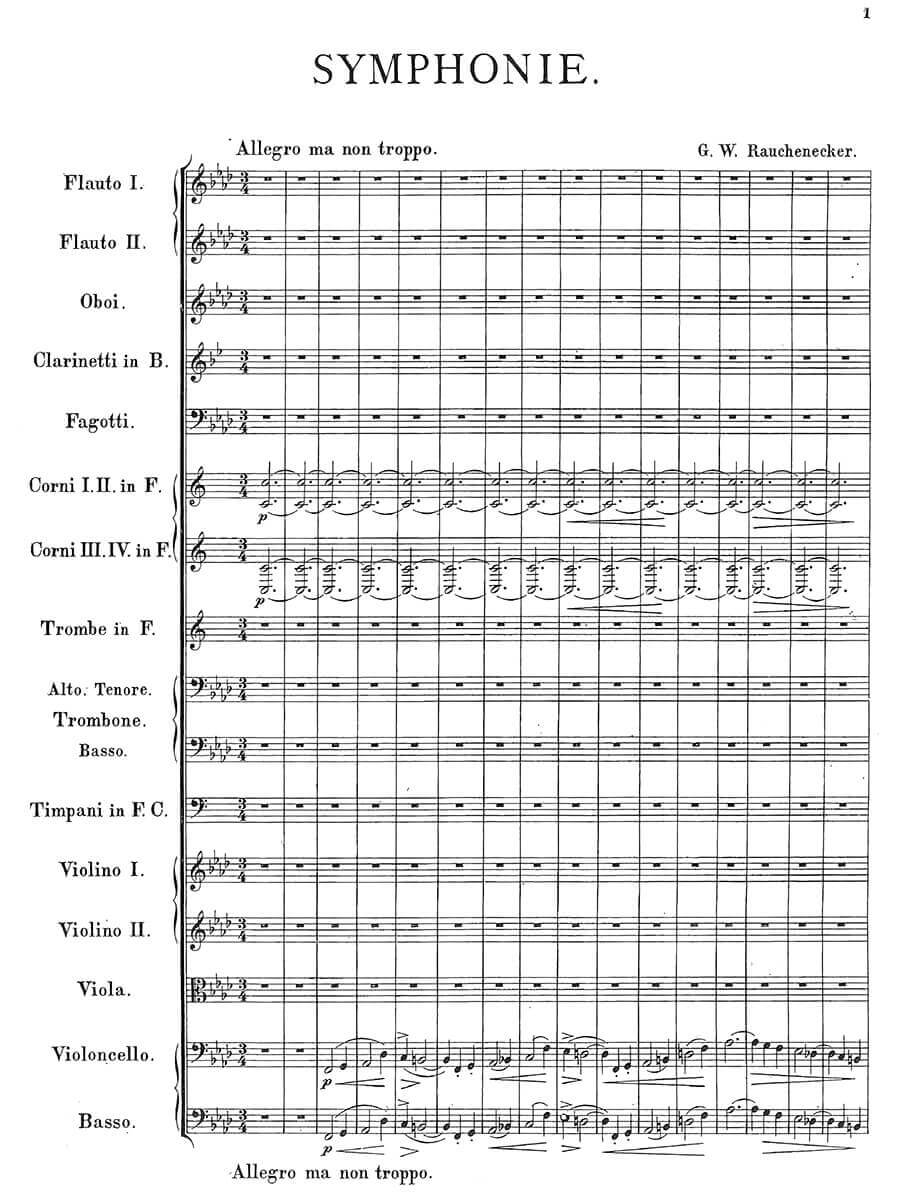Symphony in F minor for Large Orchestra
Rauchenecker, Georg Wilhelm
38,00 €
Preface
Georg Wilhelm Rauchenecker
(b. Munich, 8 March 1844 – d. Elberfeld (Wuppertal), 17 July 1906)
Symphony in F minor for Large Orchestra
(1875/76)
I Allegro ma non troppo p.1
II Adagio con espressione – Più mosso – Tempo I – Più mosso – Tempo I – Più mosso p. 50
III Allegro impetuoso p. 76
IV Moderato – Allegro vivace – Un poco ritenuto – a tempo – Un poco riten. – Presto – Tempo I p. 108
Foreword
The Munich-born composer, conductor and pedagogue Georg Wilhelm Rauchenecker was a versatile and creative figure in the musical life of Germany, Switzerland and France in the second half of the 19th century. After studying violin, piano and composition in Munich under August Baumgartner, Franz Lachner and Joseph Walter, he wrote his first compositions at the age of thirteen, among them the Sérénade pour orchestre which was premiered at the Schweiger Theatre in Isarvorstadt. A year later this extremely gifted musician joined the Munich Court Orchestra as an “arts student” and at the age of fifteen began his career teaching violin and counterpoint. In August 1860 – when he was sixteen – Rauchenecker was appointed leader of the Orchestra of the “Grand Théâtre” in Lyon. He also travelled to Aix-en-Provence, where his first opera La graine de coquelicot (1863) was given its first performance, and to Carpentras and Avignon. It was in this period that he married Elisabeth Fournial (1866) and fathered his first two children.
After the outbreak of the Franco-Prussian War in September 1870 the family was expelled from France and sought refuge in neutral Switzerland. A few months later Rauchenecker’s wife Elisabeth died in Zurich: she was only twenty-eight years old. He worked there as assistant conductor of the Tonhalle Orchestra and also gave piano lessons. In 1870, through the leader of the orchestra, Oskar Kahl, who later became his brother-in-law, Rauchenecker met the person who was to be the decisive influence upon his own artistic development: he was introduced to Richard Wagner and subsequently had various different opportunities to make music with the great man. On Christmas Day 1870 he was one of the thirteen musicians who performed Wagner’s Siegfried Idyll on the steps of Wagner’s villa in Tribschen. In the following year he studied Beethoven’s string quartets at Wagner’s house alongside Kahl (first violin), Hans Richter (viola) and Hermann Ruhoff (cello).
In 1873, after a brief interlude as conductor in Lenzburg, Rauchenecker married his second wife Anna Kempin in Zurich and moved to Winterthur where he was appointed director of the College of Music. In retrospect, we ought to regard his time working in Winterthur as having been extremely productive: during the eleven years he spent there (1873-1884) the Municipal Orchestra was founded (1875) and the Winterthur College of Music was established as an important institution in local society. In addition Rauchenecker’s commitment to the city included conducting a men’s chorus, adminstering the Music School and the post of organist at the City Church. Two more children were born in Winterthur and in 1880 he also founded a music shop there. From this point, in his capacity as a conductor, he became one of Wagner’s most ardent supporters in Switzerland and during his time in Winterthur he organised a number of concerts which were dedicated exclusively to performances of works by that great composer of music dramas…
Tranlation: Alan Howe (2017
Read full preface > HERE
Score Data
| Edition | Repertoire Explorer |
|---|---|
| Genre | Orchestra |
| Size | 210 x 297 mm |
| Printing | Reprint |
| Pages | 174 |
